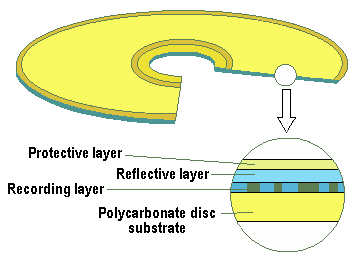| |
|
|
| |
Writing to a CD-R

image adapted
from www.pctechguide.com
|
|
The CD-R starts out with a sheet of translucent dye, such
as the cyan-blue coloured cyanin. When the write laser,
which is much more powerful than the read laser, passes
over the dye it fires bursts of intense light. These bursts
cause the dye to heat up and the chemical composition
changes to a light absorbing form. An opaque area that
will absorb the light of the read laser is created.
The dye is designed so that the read laser’s weaker
beam will not cause the chemical to alter. The alteration
must not require too much energy, so that the writer can
perform its job quickly.
|
Once the dye has darkened it cannot
be returned to the translucent phase and any data written
to the disc is permanent. CD-Rs are therefore termed WORM
(write-once-read-many) discs. After writing to the disc
it can be read as often as required, as long as the disc
itself is not damaged. |
|
|
|
|
|